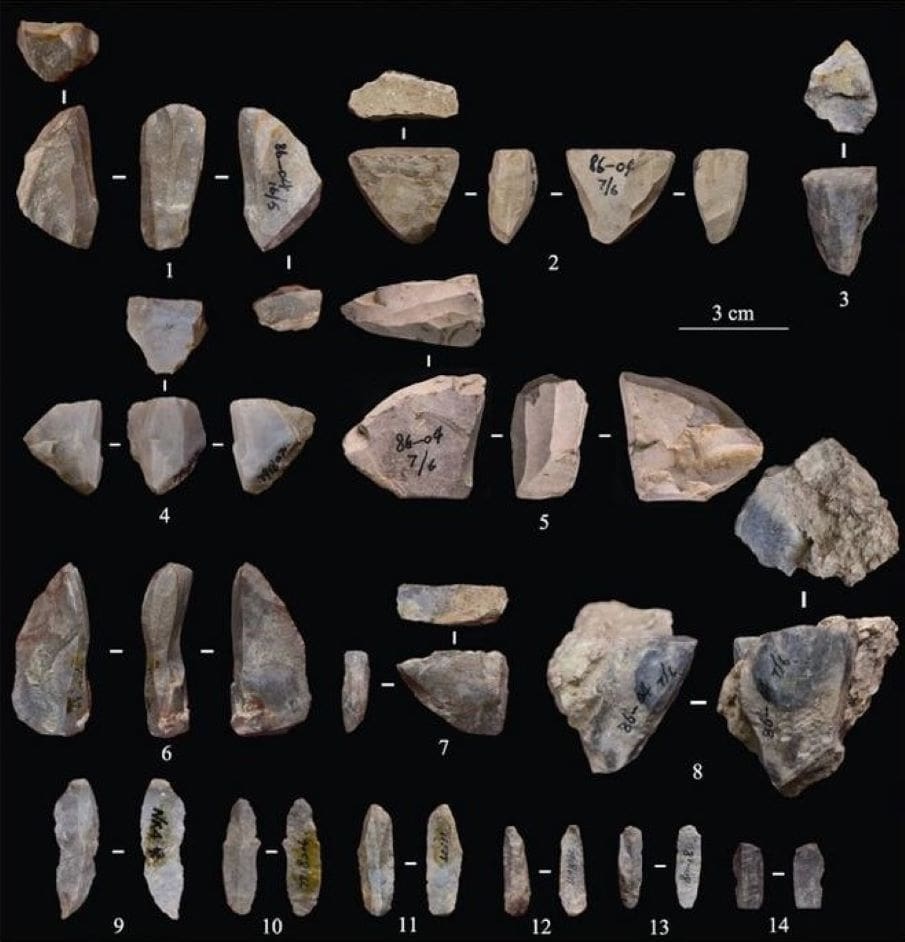Summary:
Miniaturized stone tools – tiny but efficient implements crafted by prehistoric communities – are offering new insights into how early humans adapted to changing environments. A study published in Journal of Geographical Sciences presents the first multivariate comparative analysis of lithic miniaturization in South China, revealing how technological innovation supported human survival from the terminal Pleistocene to the middle Holocene.
Researchers from the Chinese Academy of Sciences (CAS), Griffith University, the University of Washington, and the Smithsonian Institution examined more than 12,000 artifacts from three sites: Fodongdi in Yunnan, Fulin in Sichuan, and Xiqiaoshan in Guangdong. Each assemblage reflected distinct responses to environmental and demographic shifts over the past 18,000 years. At Fodongdi, small bipolar splinters were made during cooler, resource-scarce periods; at Fulin, bladelet-like flakes supported mobility in high-altitude settings; and by the middle Holocene, Xiqiaoshan showed standardized microblade production linked to northern influences.
According to corresponding author Yang Shixia, the study demonstrates that lithic miniaturization in South China “was not a marginal phenomenon but a central adaptive strategy.” The findings reposition the region as a crucial area for understanding human resilience and innovation during times of climatic and population change.

Small but mighty: Miniaturized stone tools reveal human resilience to climate change
Miniaturized stone tools have long been recognized as hallmarks of human adaptation, but their role in South China has remained scarcely investigated. A new study provides the most detailed analysis to date of three archaeological sites spanning from the terminal Pleistocene to the middle Holocene. Researchers applied advanced quantitative methods to more than 12,000 artifacts, revealing distinct strategies for producing small, portable, and efficient tools. These included bipolar splinters, bladelet-like pieces, and standardized microblades.
The findings highlight how human groups used technological innovation to respond to fluctuating environments and shifting population dynamics, demonstrating the flexibility and resilience of prehistoric groups in this crossroads region of Asia.
During the Late Pleistocene, human populations across Asia developed a diverse range of stone-tool technologies. In northern China, microblade industries have been extensively documented, while South China was long thought to be dominated by cobble-tool traditions. Recent discoveries, however, have revealed overlooked evidence of lithic miniaturization, suggesting a broader technological repertoire than previously assumed.
Miniaturized artifacts are linked to advantages such as efficient raw material use, longer cutting edges, and improved transportability – features critical in times of ecological stress or high mobility. Yet, questions remain about their development and spread across South China. Due to these gaps, in-depth research on lithic miniaturization in South China is urgently needed.
A team of Chinese and international researchers from the Institute of Vertebrate Paleontology and Paleoanthropology, Chinese Academy of Sciences, together with collaborators from Griffith University, the University of Washington, and the Smithsonian Institution has now conducted the first multivariate comparative study of lithic miniaturization in South China.
The findings were published in Journal of Geographical Sciences in May 2025. The study analyzed assemblages from Fodongdi in Yunnan, Fulin in Sichuan, and Xiqiaoshan in Guangdong, spanning roughly 18,000 to 5,600 years ago. By combining techno-typological analysis with statistical tools such as Principal Component Analysis and K-means clustering, the researchers traced the evolution of miniaturized stone technologies and their links to changing climates and human populations.
The study examined more than 12,000 artifacts, identifying 456 bipolar pieces at Fodongdi, 222 bladelet-like pieces at Fulin, and 387 microblades at Xiqiaoshan. Each site reflected different ecological settings and chronological contexts. At Fodongdi, located in tropical Yunnan, quartz pebbles were systematically reduced into small elongated splinters during cooler, resource-scarce phases of the Last Glacial Maximum. At Fulin, next to the eastern edge of Tibetan Plateau, tiny bladelet-like flakes were produced around the Younger Dryas, offering portable and efficient hunting tools in a rugged, high-altitude environment.
By the middle Holocene, the Xiqiaoshan assemblage demonstrated highly standardized microblade production, including wedge-shaped and conical cores, likely driven by the demographic expansion of northern populations. Statistical analyses confirmed that these miniaturized lithics formed distinct clusters, reflecting intentional design rather than by-products of flaking. Across the three sites, a trend toward more standardized and elongated forms emerged, with average length-to-width ratios increasing over time. The results show that multiple technological systems converged on similar small, portable toolkits, highlighting a shared adaptive logic that linked human survival strategies to environmental shifts and growing populations.
“Our findings demonstrate that lithic miniaturization in South China was not a marginal phenomenon but a central adaptive strategy,” said corresponding author Yang Shixia, Associate Professor of Paleolithic Archaeology. “By comparing different sites across ecological zones, we see how communities responded innovatively to climatic fluctuations, population pressures, and cultural interactions with northern regions. The convergence toward miniaturized tools underscores the flexibility of human technological systems and provides a new lens through which to understand the dynamics of human evolution in Asia during the Pleistocene-Holocene transition.”
This research reframes South China as a key region for exploring technological innovation in human prehistory. The identification of diverse miniaturization strategies reveals how ancient groups adapted flexibly to varied ecological challenges – from glacial cooling to coastal subsistence shifts. Beyond enriching archaeological theory, the study underscores the value of combining advanced statistical approaches with traditional lithic analysis.
Future interdisciplinary work, integrating ancient DNA, paleoecology, and material culture, could further clarify how climate and migration shaped human resilience. By illuminating how small tools supported big transitions, the study contributes to broader discussions of human adaptability in the face of environmental change.
Journal Reference:
Huan, F., Yang, S., Marwick, B. et al., ‘Lithic miniaturization in South China since the terminal Pleistocene: A multivariate analysis of lithic reduction from Fodongdi, Fulin and Xiqiaoshan’, Journal of Geographical Sciences 35, 1619–1641 (2025). DOI: 10.1007/s11442-025-2375-7
Article Source:
Press Release/Material by Maximum Academic Press (MAP)
Featured image credit: Journal of Geographical Sciences



